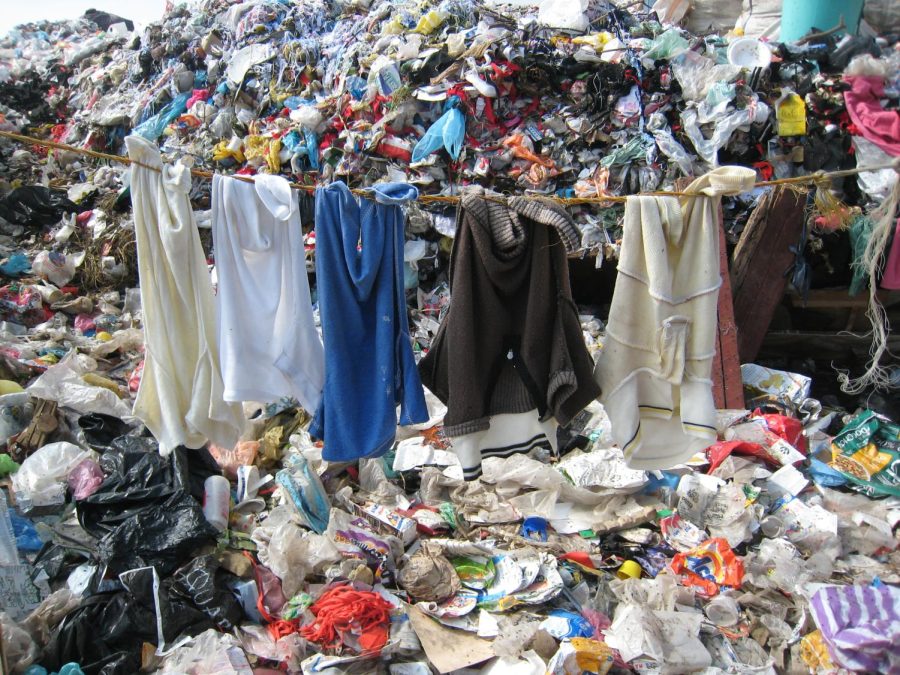Micro-trends and their not-so-micro impact on the environment
Annually, 85% of clothing in the U.S. is thrown in a landfill or burned, contributing greatly to air and land pollution.
November 29, 2021
The coconut girl aesthetic, tie-dye and low-rise jeans are all perfect examples of micro-trends. When these trends begin, production of similar styles increases exponentially and when they are deemed out of style, the clothes are thrown away. What the participants of these trends do not often consider, however, are the harmful effects this cycle can have.
The fashion industry revolves around ‘trend forecasting,’ traditionally influenced by a small number of the most socially-elite, colors, trend-cycles and textures. But, with the rise of social media, even more specifically TikTok, these trends have become increasingly hard to predict. A new facet of the fashion industry is the existence of ‘micro-trends.’ These trends begin and end on social media and are perpetuated by infamous drop-shipping companies such as SHEIN and AliExpress. As micro-trends continue to cycle in and out, it becomes more and more important to realize the detrimental effects of micro-trends on the environment.
The fashion industry has become the second largest polluter in the world, rivaled only by the oil industry. The United Nations Environment Programme finds that in the past 15 years, clothing production has doubled, with the average customer now buying 60% more clothing and keeping items for half as long. While macro-trends last 5-10 years, a micro-trend’s lifespan can be less than a few months. As long as social media continues to showcase different micro-trends every week and companies like SHEIN make keeping up with them more affordable and accessible, these trends will continue to thrive. And as long as micro-trends are considered the norm, clothing waste and production will continue to increase. When production increases, so does the impact fashion has on climate change, as the fashion industry already accounts for 10% of greenhouse gas emissions and is on track to increase 50% by 2030, according to the World Bank. They also project that if “lifestyle trends,” such as the rise of micro-trends, continue, global consumption of apparel will rise to 102 million tons by 2030. Sustainable production of clothing is important to mitigating these effects but the lifespan of clothing has more of an impact than anything else. While if everyone bought quality clothing pieces and kept them for five years, not only would pollution from production decrease, but also pollution from the clothing items themselves.
Along with the drastic effects of micro-trends on the environment, they also support the growth and popularity of drop-shipping online stores such as ROMWE, SHEIN, Zaful and AliExpress. The term ‘drop-shipping’ refers to a store that sells a product but does not supply it or ship it, but rather hands those responsibilities to a third-party supplier. Most of the companies selling these micro-trends run through the same third-party supplier, with virtually no transparency on the source of the products. In an interview with Forbes, SHEIN’s Chief Marketing Officer Molly Miao stated the store “drops 700-1,000 new styles daily.” This, combined with the high volume of orders the website receives and the insanely low prices of products, means the labor conditions of the third-party’s workers are inevitably very low. While the specific source of products is unclear for any of these drop-shipping companies, it is almost guaranteed that a portion, if not most, of the labor is unethical.
While the in-style clothing and low prices of shops like SHEIN can be tempting, the support these stores receive and the trends they maintain cause immense damage to the environment and support unethical labor practices. Sustainable shopping methods, such as ethically sourced shops and thrift stores, the latter which generally boast prices similar to drop-shipping companies, are both solutions to these issues. Whether it is through second-hand shopping or simply by keeping clothing for longer, the elimination of micro-trends is crucial to the mitigation of fashion pollution’s effects on the global environment.










marge • Nov 30, 2021 at 1:23 pm
such a good story emma! very informative on an important issue